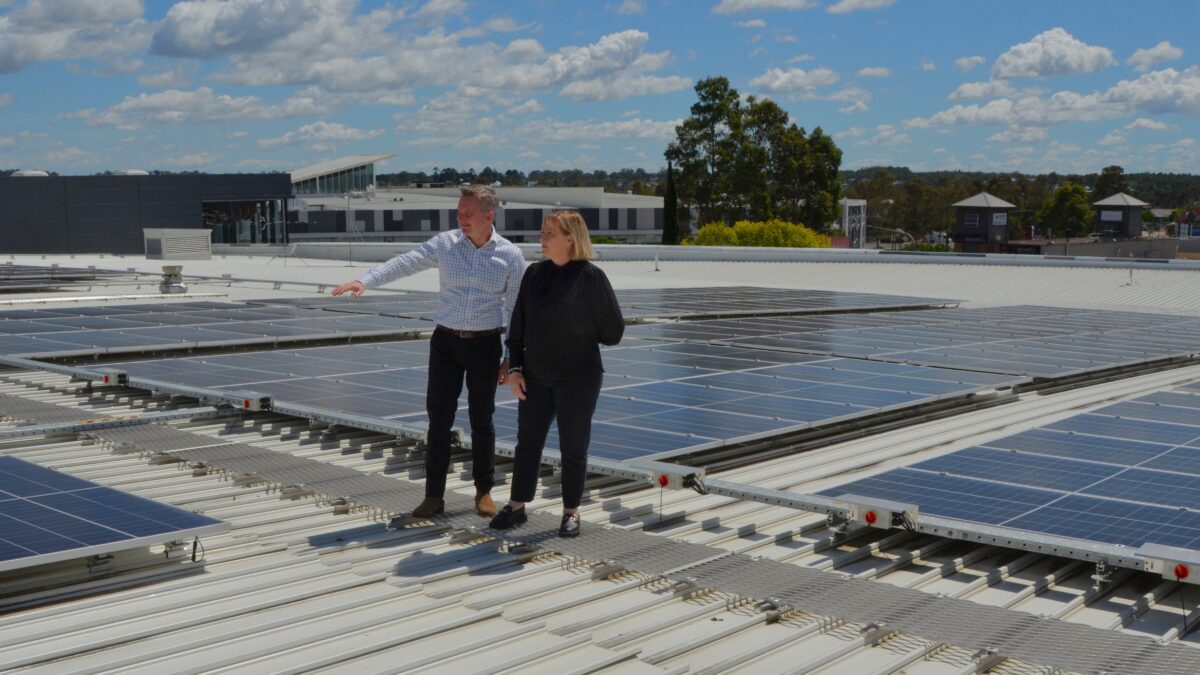The freshly installed solar rooftop powerplant at Narellan Town Centre shopping complex has been officially launched by Federal Energy Minister Chris Bowen. According to CEP.Energy, the PV array now generates enough energy to provide just over one-third of the total energy consumed by the shopping centre.
The project first kicked off towards the end of 2020, when the owners of Australia’s largest privately owned shopping centre inked a deal with CEP.Energy with a 30-year lease agreement. CEP.Energy agreed to invest up to $40 million (USD 26.6 million) to install, own and operate the embedded solar and battery network. In 2021, CEP.Energy engaged renewable infrastructure specialist RACV Solar to supply and install stage one works now completed.
In this first phase, a 2.6 MW solar system has been installed across 12,577 square metres of rooftop with what RACV Solar has said are 5,624 Trina 500 W PV modules.
In 2021, RACV Solar said the project was also to involve 22 Sungrow CX range inverters and 4 MW/10 MWh CATL and Delta battery energy storage systems (BESS).
According to CEP.Energy, there are 12 of these batteries on onsite, which is equivalent to 800 residential batteries, holding the capacity to feed enough power back into the grid to supply electricity to more than 1900 homes. The power generated is enough to supply 35% of the electricity consumed by the shopping centre.
In announcing the completion of this first phase, CEP.Energy Chief Executive Officer Peter Wright said, “We now look forward to working on stage two at Narellan Town Centre, which has the potential to deliver an enhanced solar system totalling 10 MW, and increased battery storage of up to 20 MW.”
When CEP. Energy announced the project in 2020, the company said that when complete, it will include a 50,000 square metre array of solar modules delivering 10 MW of renewable energy supported by a 20 MWh battery storage system.
The Narellan Town Centre lies between two major roadways in Sydney’s airport corridor and is owned by Dart West Retail in a partnership between the Vitocco and Perich families. Besides 220 retail outlets and a cinema complex, the shopping centre also houses 3,000 customer car parking spaces.
Herein lies a future challenge for the large-scale shopping facility – if all these car parking spaces are to be electrified, the shopping centre will need vastly more power production to maintain the same ratio of renewable power production to consumption as has been achieved with this first solar array. This will be a growing concern since Dart West Retail aims to expand the shopping centre from 76,000 to 135,000 square metres over the next 10 years.
Electric vehicle charging facilities at shopping centres elsewhere in Australia are moving forward as charging points draw customers, reduce local pollution levels, and meet climate change targets. This year, Ampol announced it would install fast charging stations across Australia, partnering with Mirvac to roll out 72 charging stations at retail precincts from the end of this year.
Shopping centre conglomerate Vicinity also recently announced that it will install electric vehicle charging infrastructure at up to 30 locations within the next two years. In Sydney, Vicinity owns Chatswood Chase, the Queen Victoria Building, the Strand, and other similarly large centres elsewhere in Australia.
Shopping centres can, of course, also reduce their transport electricity demand with the provision of more sustainable transport options such as public transport options and increased cycling infrastructure in collaboration with municipal and state governments and public transport providers.
Either way, renewable energy providers like CEP.Energy have a greatly expanding market to look forward to.
CEP.Energy has already declared it wants to install gigawatts of solar and battery storage around Australia by 2025. Its partner in the Narellan Town Centre project, RACV Solar, is the photovoltaic wing of the Royal Automobile Club of Victoria, which has an obvious incentive to produce more power for its members as the transport transition inexorably progresses.
This content is protected by copyright and may not be reused. If you want to cooperate with us and would like to reuse some of our content, please contact: editors@pv-magazine.com.








By submitting this form you agree to pv magazine using your data for the purposes of publishing your comment.
Your personal data will only be disclosed or otherwise transmitted to third parties for the purposes of spam filtering or if this is necessary for technical maintenance of the website. Any other transfer to third parties will not take place unless this is justified on the basis of applicable data protection regulations or if pv magazine is legally obliged to do so.
You may revoke this consent at any time with effect for the future, in which case your personal data will be deleted immediately. Otherwise, your data will be deleted if pv magazine has processed your request or the purpose of data storage is fulfilled.
Further information on data privacy can be found in our Data Protection Policy.